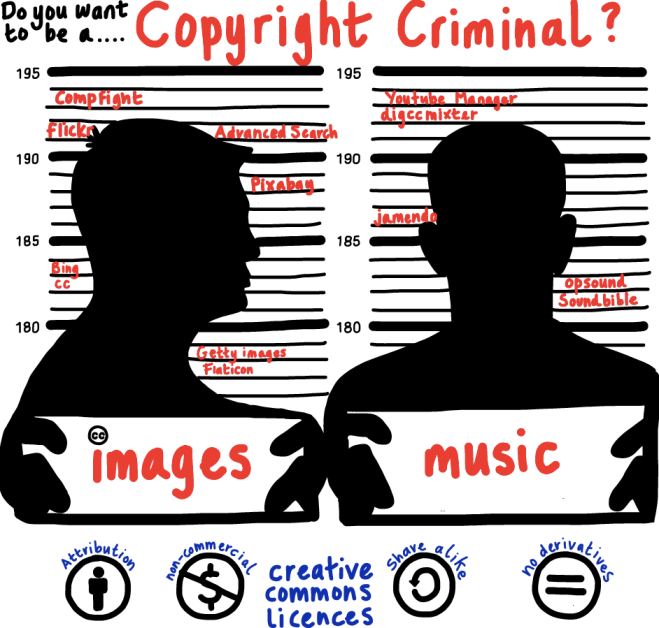Have you ever used an image from Google search without looking at who or where it originated from? Have you dropped a nice music track into a video without thinking of who owns it? I am sure most of us have in the past and I am sure many of our students have no idea about the ethics of posting images and using music from the internet. It’s time to bring in the Internet Inspectors and show them this video:
Common Craft also explain it visually in their video on their site here.
Nowadays it is much simpler to find and use images and music online that the owners have allowed wide spread use. There is no excuse for teachers or students to not consider the original designer, photographer or musician.
Today we find that even more options are available to us. Recently I was told by Vivian on Twitter, that Getty is now offering 35 million images from its extensive database for non-commercial use. In Timothy Vollmer’s article on March 7, 2014 he says:
“Getty is clearly seeing its images appear across the web anyway, so it’s decided to go down the embed road, similar to how other content providers like YouTube handle the media they host. By requiring embedding, Getty will be able to track where its photos are being used online, and reserves the right to display advertisements. The announcement demonstrates a general understanding that Getty needs to meet users halfway in providing content in ways that is affordable, useable, and aligned with how people wish to share online today.” (http://creativecommons.org/weblog/entry/42278)
Using images ethically
Currently we are able to grab imagery from a number of easy sources, and upon asking students where their preferred method of image finding is, they nearly always state Google images. It is apparent that the message of Creative Commons and Copyright has not got through and it is our job to spread the word and educate first the teachers in order to pass on to their students. I wonder how long it will take google to work with Creative Commons and ensure students and adults are able to choose that option up front when visiting the site. Would it be that difficult to add a simple filter to Google images front page or install it as default? As an educator this would be invaluable until the day that students fully comprehend and are responsible in their usage of images. Today through Compfight, Flickr Advanced Search and Bing to name just a few, we are able to search countless CC images. In Jeff Plaman’s post, Doing what’s right, not just what’s legal back in 2011, he talks about the law being different in US compared to China, yet it is making ethical choices that is more important. Jeff says,
“just because the law is different in the place where you currently are, doesn’t mean that you should necessarily change your behavior just because previously banned behavior is legal in your new location. Therefore, an ethical approach that transcends locale, founded on respect for the work of others is preferable.” (Their Future, September 23. 2011)
In respect of this, and in my job as an Art teacher I will ensure all our staff teach their students how to search and use imagery effectively and ethically and it is in developing the UBD lesson with Matt and Anne that this will be possible. Using a one off lesson format with the opportunity to expand or extend this practice, students will understand how their own images can be made available for others to use through the Creative Commons licences.
Back in my blog post Stepping Safely into Cyberspace, the video “Once posted you lost it” resonated strongly with my tutor group of 13/14 year olds. Talking them through my post and allowing them to share their thoughts about posting and commenting made me realise how much they lacked in knowledge and ethics. It seems to make sense that I approach this unit directly with them first as the age group seemingly most in need of advising. Students will always take the easy and quickest solution so it might take some convincing for them to change their habits.
Music is a huge part of teenager’s lives and features heavily in their day to day social interactions. They make or watch videos on a regular basis but are not aware of the laws of using other’s music.
Stealing or Sampling?
Recently on the ADE Singapore camp we watched a short film called Copyright Criminals (well worth a watch if you haven’t seen it) centring around the use of sampling in the music industry. It was fascinating to watch the progression of this art to what we know it to be today, from its humble beginnings and its impact on creative individuals. It triggered heated conversations about how much a musician may use and confusion over whether in fact sampling was a crime or creativity. What are your thoughts on this? Should musicians be allowed to use parts of or backing music and remix other’s music without their permission? My thoughts initially were that without their permission this was surely wrong as in the case of Clyde Stubblefield the “funky drummer” with James Brown, who is arguably the most sampled man ever, yet he received no money or acknowledgement for his part in the huge success of modern music. Where there is blatant copying, is it right to prosecute? But how far can this go? What if someone uses 3 notes or a sequence of chords that resemble another? Clearly there is a blurred line between what should and should not be used in the music industry. Perhaps artists, like photographers, could have a code of usage that they license their work with, allowing the creativity of modern day remix music to continue yet reviving the original song or piece with correct attribution.
Nowadays, asking on Twitter “what are your favourite go-to sites for CC music”, there are several choices to pick from: Jamendo, with over 350,000 audio files from different countries and in different languages and unlimited streaming and downloading; Free Music Archive, Soundcloud and the most popular ccmixter. CcMixter is a community music site featuring remixes licensed under Creative Commons where you can listen to, sample, and interact with the music. You can find more links to music downloading in the article on Hongkiat.
In my day and throughout my teaching career, plagiarism has always been that word that puts the fear of god into a student submitting an essay or project. These days Turnitin helps teachers to track how much work is similar or taken from other sources and even where or from whom that source is similar to. My husband teaches Physics and he uses it to feedback draft work to students as well as check that they are writing authentically. He was able to see that one student’s work was remarkably similar to another student’s in Singapore and could approach him to see whether they had worked on it together. It is imperative that our young learners are educated in ethical ways as we were when we were growing up.
You wouldn’t submit a book or article based purely on copied text from another, so why does this not apply to images and sound? Surely this use of others’ material should apply to the world of music and art?
Clearly this is a contentious discussion and I would love to hear your thoughts on it.
By the way……..linking back to early on in Course 2, have you seen Banksy’s new artwork in Cheltenham on Privacy?


